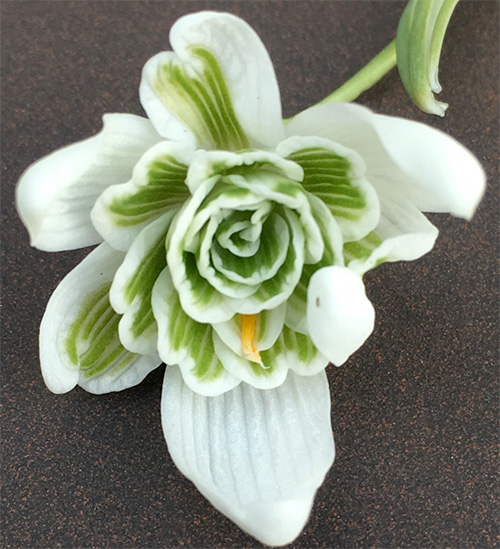
By Tara Lissner, Swiss Gardening School
I do so love a snowdrop! One of the very first signs that the depths of winter are behind us. Their delicate hanging flowers suspended from a tiny stem piercing the earth with the message that spring is on the way. Although we have been rather spoiled this year with a mild winter season it is still rather nice to see the changes in the garden. With bulbs forcing their way through the soil and shoots appearing on everything from roses to forsythia – it is time to get ready to get back to work.
I have found it to be quite challenging to find interesting Snowdrop bulbs here, most garden centres sell the traditional Galanthus nivalis, common snowdrop. I am always on the look out for something a little more special like the Galanthus nivalis ‘Flore Pleno’ pictured above. If you are lucky enough to have some in your garden, and your drift is looking a little cramped, now is the time to split them. Snowdrops do not like to dry out whether in bulb form or in the green (the term used for the way snowdrops are dug up for planting once the flowers have gone over) so be quick. By digging up a dense clump, gently teasing the bulbs apart and replanting the new smaller clumps you will increase your display. When replanting make sure you add a few handfuls of fresh new soil to the hole and water them in well. As they are one of the first bulbs to show up it is important that they are planted where they can be easily enjoyed, next to a front door, or along a hedge to a gate. Splitting them like this encourages the growth of tiny new offsets thus bulking up the new clump. There has been quite the renaissance in interest in these tiny bulbs, a new world record was set in February 2015 for GBP 1390 for a single bulb Galanthus placates ‘Golden Fleece’ – it took 10 years to breed and another eight to produce enough to sell! If you are interested in more out of the ordinary snowdrops take a look at this website run by the galanthophile Joe Sharman from Cambridgeshire, I may have to order some bulbs later this year.
With the snow behind us, we hope, and the sun warming things up there is plenty to do outside. Here are a few suggestions: having enjoyed the bright red, green or yellow stems of the cornus (dogwood) all winter, now is the time to cut them back to the ground. While a very dramatic task it will ensure brightly coloured new growth to be enjoyed next winter, if you leave it be and do not cut all the way back the brightly coloured stems become darker with time and you loose the wow factor.
The now untidy perennials which were left standing for winter interest really do need to be tidied up. Cut them back to the ground being careful to not damage any new growth at the base. This is also the ideal time to split these herbaceous perennials thus creating more plants for your garden. The pretty flowerheads of the Hydrangea paniculata which may also have been left standing over the winter are now ready to be trimmed back. Dead-head the dried flowers and cut back to about one third of last year’s growth.
The next stage is mulch. Mulching your beds does three things, it improves the soil structure, it keeps the weeds down and it helps the soil retain moisture. Once you’ve tidied up your perennial beds, weeded them, and turned the soil add a good 10cm layer of organic mulch. There are a number of different types of mulch to use, well rotted manure from the local stable, compost or leaf mould from your own garden, compost from your town supply or inorganic matter like stones or pebbles for smaller spaces.
Looking at the vegetable plot, now is the time to work the green manure you planted before the winter into the soil (I used winter spinach this year). Turn the soil containing the green manure and leave for at least two weeks to allow it to rot down. The other beds should be turned, removing weeds as you work and adding as much compost as you have to hand. As it is a little early to think about planting outside why not spend some time gazing over a seed catalogue identifying what to grow. One of my favourite seed catalogues is from the British company Thompson & Morgan but local garden centres are packed with choice at the moment, it is time to make decisions about what to grow this year. I’ll be trying out a variety of chili pepper seeds to see which work best in my garden.
If you are lucky enough to have a permanent strawberry bed, now is a good time to rejuvenate it for this growing season. Take a secateurs and trim back the outer larger leaves damaged by the cold weather. The new growth from the crowns will develop into blossom and eventually fruit. Weed the bed and add a granular slow-release fertilizer along with some compost to act as a mulch.
Another perfect job for inside is to start off potato chitting. Pick up some seed potatoes from you local garden centre. Place the seed potatoes into egg boxes in a sunny warm place until the knobbly dark shoots develop, about 10-14 days, this process allows them to get off to a great start when they are planted in the ground. This waiting process also allows you a little time to prepare the space into which you’ll be planting them in a couple of weeks. I’ve stared some earlies on a window ledge, a variety called ‘Sirtem’, once planted they should be ready to harvest in 60 days – now that is something to look forward to.
What's on
Fête de la tulipe, Morges until 8 May
Each October the park and gardens department for the town of Morges devote 30,000m2 to the planting of 350 varieties of tulip, a staggering 120,000 bulbs. They can be found at the Parc de l'Indépendance and around the fountains of the Grand Rue and the rue Louis-de-Savoie. This year some 30,000 bulbs have been donated by the city of Istanbul. Once they have finish blooming, the bulbs are dug up and on Wednesday 11 May at 11:30 they may be purchased by the public for a nominal amount. If kept in a cool, dry and dark place you can plant them up from October in your own garden.
Fête de la tulipe
Journées des Plantes au Lac d'Aiguebelette, 23-24 April, 10:00-19:00
Situated close to Chambéry, just over an hour from central Geneva, the spring edition of this plant fair attracts growers from all over France who come to share their knowledge and plants. Located in fields above the Aiguebelette lake wellies are recommended in case of inclement weather.
Lac d'Aiguebelette
Les Bucoliques, Abbaye de Salaz, near Aigle, 29 April - 1 May, Friday 14:00-18:00, Sat & Sun 09:00-18:00
Described as a weekend devoted to gardens, plants and flowers. Over 30 exhibitors including some of our favourite horticulturalists and garden-related companies will be present R. Jaggi, Pépinière Le Bioley, Alex Schofield and FELCO.
Les Bucoliques
JardiTroc, Troc des plantes et marché, Grand-Saconnex, Saturday 30 April, 13:00-17:00.
This is the annual plant swap of a Geneva-based association that aims to encourage contact and interaction among garden enthusiast members.
Jardi'troc
Jardins en fête, Château de Coppet, 6-8 May, 10:00-18:00
Nicknamed the Chelsea of Switzerland this annual event is held in the gardens of the Château de Coppet. Packed with a huge variety of exhibitors from vegetable and peony growers to garden furniture sellers and landscapers we too will be present running our ever popular pop-up classes. A date for the diary. (no dogs)
Jardins en fête
Les ateliers verts, Conservatoire & Jardin Botanique, Geneva, Wednesdays, 14:00-16:30
This spring another seven workshops are scheduled for children (8-11 years) until 15 June. The workshop are in french and inscriptions are essential.
Les ateliers verts
Schilliger, Gland, open seven days a week until 29 May 2016 09:00-18:00 (18:30 Monday - Friday)
For all your gardening needs this growing season.
Schilliger Gland
Courses
Our new course list is on the website and this year we continue our off-site workshops at local nurseries, our evening master classes and have we've introduced two garden tours. We are particularly excited to run our first Geneva course at the wonderful Ferme de Budé in Petit Saconnex. Details of registration and payment is via the website, sign up so as not to be disappointed.
The Edible Garden - Vegetables, Tuesday 26 April, 10:00-12:00, Ferme de Budé, Petit Saconnex
What to plant for success, when to get started, what to do with so many tiny seeds? So many questions, join us on this organic farm and see how the professionals get the best crops.
The Edible Garden - Vegetables
Evening Class - Pruning Techniques, Thursday 28 April, 19:00-21:30, Founex
Remove the mystery from this essential skill and try a range of implements for all the pruning tasks in the garden.
Evening Master Class - Pruning Techniques
Wishing you a gentle introduction to a year in the garden.
Author's bio

An enthusiastic, self-taught gardener, Tara Lissner is passionate about gardening and eager to share her zeal and knowledge with other gardening fans.
In 2012, she joined forces with Hester Macdonald, a British-trained landscape designer, to launch the Swiss Gardening School.
(Photo by Jean-Luc Pasquier)
Swiss Gardening School
www.swissgardeningschool.com










